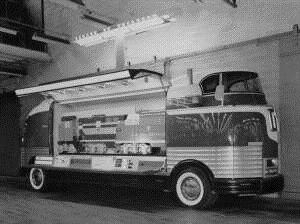|
HOME
'33 World's Fair
1936 Parade
1938 Previews
1941 Parade
1953 Parade
1954 Parade
Aero-O-Dome
Exhibits
Demonstrations
Appreciation Letters
Futurliner
Development
Page 1
Page 2
Page 3
Page 4
Page 5
Mich. Police
Displays
Mich. Gov.
On Tour
Vic
Hyde
Model
In-Line Six
Other Futurliners
Paraders
Oral
Roberts Cathedral Cruiser
|
1940-1952
FIRST GENERATION FUTURLINERS
In 1940, 12 first-generation Futurliners
were built to replace the original eight Streamliners. The Futurliner
caravan consisted of 24 trucks, 11 passenger cars and three station
wagons. The old Streamliner caravan consisted of 25 trucks and 19
different passenger car-units. The early show had five major exhibits,
while the latter had 15, plus two Army trucks which formed part of the
Defense Exhibit. The most spectacular of the new pieces of equipment was
the Aer-O-Dome tent. It seated 1,500 people and was built like an inverted
umbrella with ribs exposed. In 1946,
after a WWII hiatus, several of the Futurliners were in a Detroit parade
to commemorate the fiftieth anniversary of the invention of the
automobile.
1953-1956 SECOND
GENERATION FUTURLINERS
In 1953, the Futurliners were rebuilt
into their second-generation form. In 1956, just three years after
their rebuild, the popularity of the show waned and the Futurliners
were either sold or donated. Approximately 13 million people in nearly 300
cities nation-wide saw the 12 vehicles roll into their town and enjoyed a
free show that provided them with a glimpse into the future.
|
 Twelve Futurliners
were built and used by GM to transport the GM Parade of Progress show throughout
the United States from 1941 to 1956.
Twelve Futurliners
were built and used by GM to transport the GM Parade of Progress show throughout
the United States from 1941 to 1956.
The Futurliners transported dioramas
and exhibits, featuring futuristic things such as: a microwave that fried an egg without
burning a newspaper; a Ping-Pong game in stereophonic sound and; sound traveling over a
beam of light produced by a flashlight.
The Futurliner is a massive bus
like vehicle, 33’ long, 8’ wide, 11’-7" tall vehicle with a whopping
248" wheelbase. An unusual feature of the Futurliner is its dual (side
by side) front wheels. Each wheel has its own set of brakes, brake drums and
bearings. Nearly all of the Futurliners had problems with their power steering
pumps failing, presumably because of the tremendous force required to turn the wheels.
The pre-1953 Futurliners were powered by 4-cylinder diesel engines and 4x4
mechanical transmissions. The 1953 version, however, is powered by a 302 inline 6 cylinder
OHV GMC engine. The engine is coupled to a Korean War vintage four speed Hydramatic
automatic transmission that is bolted to the backside of another two speed gearbox. This
gives the driver the option of selecting from 8 forward speeds. Complicating this a bit
more is another 3-speed PTO gearbox. To shift this gearbox, the driver must leave the
cockpit (presumably with the vehicle stopped) and travel to the rear quarter of the
vehicle and manually select one of the three gears. With this combination, the driver now
has 24 selections to choose from. The restoration crew reports that the rear-end has yet
another gear reduction, but they haven’t figured out quite how that works yet. In
spite of the gearing ratios, some of the original "Paraders," as they
referred to themselves, recall attainable speeds of not much more than 40 mph! The Futurliners
packed two 45-gallon gasoline tanks!
The original Futurliners, prior to their 1953 refurbishing, had bubble canopies
over the cockpit (driver’s compartment), similar to a fighter plane of the era. This
arrangement was brutally hot for the drivers and the vehicles were not air-conditioned!
The cockpit is reached by climbing a stairway to the top of the 11’-7" vehicle.
This positions the driver’s head at about the 11’ level and makes for a
terrifying first time experience when going under an overpass!
The vehicle has an incredible 19 access and display doors on it. Two massive 16x5’
doors open to expose the display housed within the vehicle. A 16’ lighting panel is
attached to the top of the overhead doors and a large light bar rises from the roof
another 7’ up above the Futurliner for additional illumination. To provide
electricity for all this lighting, a massive twin 6-71 200KW Detroit Diesel generator was
used.
Because the brakes were so poor, one Futurliner rear-ended another and
consequently they were instructed to stay 300 feet apart. They all had radio receivers but
only the lead and tail vehicle had transmitters. The Futurliners were nicknamed the
"Red Elephants."
The name "FUTURLINER" was spelled without the
"E" in FUTURE so GM could copyright or trademark the name.
|
 Twelve Futurliners
were built and used by GM to transport the GM Parade of Progress show throughout
the United States from 1941 to 1956.
Twelve Futurliners
were built and used by GM to transport the GM Parade of Progress show throughout
the United States from 1941 to 1956.